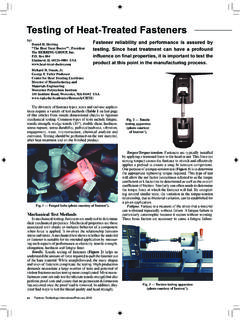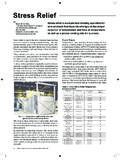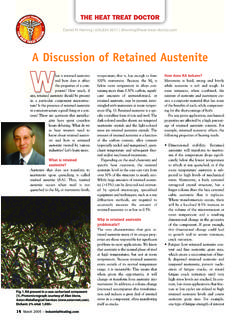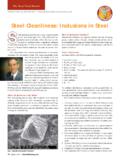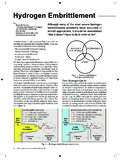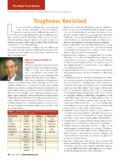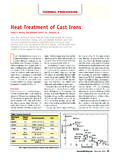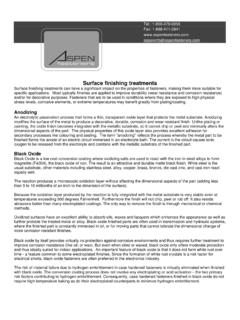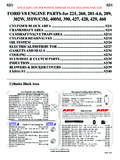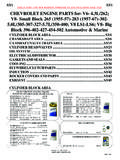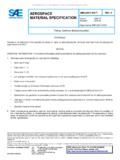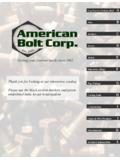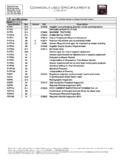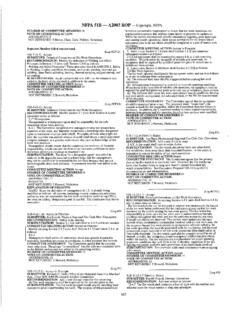Transcription of Cleaning of Fasteners Before & After Heat Treating
1 Cleaning of Fasteners Before & After heat TreatingMany fastener heat treatment operations must deal with poorly cleaned parts. This is especially challenging with re-spect to controlling the furnace atmosphere and also results in higher than normal equipment maintenance. While most atmosphere heat treat processes can tolerate some degree of wet or oily parts (Figure 1), there is no excuse for not taking the time to understand how to better clean these is defined as the application of time, temperature, chemistry and energy to remove contamination from the sur-face of a part to a level appropriate for the intended applica-tion. In other words, Cleaning is simply moving contaminants from where they are not wanted (on the parts) to where they should be (in the waste disposal system).
2 If all four aspects of the Cleaning process are not working together, the parts will not be properly cleaned. Although heat Treating demands only a moderate level of cleanliness compared to many industries, contamination left on parts can cause significant problems in our equipment (Figure 2) as well as in the end result ( , spotty hardness, uneven case, etc).All Cleaning systems depend on one or a combination of three basic actions: A physical action, that is, a mechanical force, such as spray agitation, dunking, ultrasonic methods, or even hand (abrasive) Cleaning , to remove the contaminants from the xx fastener Technology International/June 2010 part surface.
3 A thermal action to improve the activity of the Cleaning solution and increase the kinetic energy of the system. A chemical action to allow contaminants to be either desorbed from the part surfaces with the aid of surface active agents or dissolved by an action of absorption and CleaningAqueous Cleaning is the dominant approach used in our industry. Its simplicity, ease of use and overall flexibility is what makes it an attractive process. Aqueous Cleaning uses detergents to lift contaminants from the surface of the parts; heat to make the detergents more compatible with the contaminants and to soften them; fluid force to dislodge the contaminants from the parts and to collect the insoluble contaminants in some removal systems and time to allow the process to take , aqueous Cleaning is not perfect.
4 It often leaves a surface residue or film on the parts, which may interfere with such processes as case hardening. As a result, a fresh water rinse followed by a tumble dry is often recommended for Fasteners . Aqueous cleaners don t dry well and the solu-tion is often difficult to remove from internal part surfaces such as holes, crevices and recessed areas. Finally, aqueous cleaners evaporate slowly, requiring large amounts of energy to dry them and have been known to damage certain sensi-tive CleaningCleaning in a solvent offers a level of simplicity and forgiveness not seen in aqueous methods. Solvent Cleaning involves three basic steps: wash, rinse, and dry.
5 Washing is where the parts are immersed in or contact the solvent, which is typically boiling to help the removal process. The purpose of rinsing is to bring fresh or clean solvent in contact with the parts. The aim is to dilute the contaminated solvent present on the surface of the parts from washing. It is important to remember that the rinse solvent must be kept by:Daniel H. Herring The heat Treat Doctor , PresidentThe HERRING GROUP, Box 884 Elmhurst, IL 60126-0884 D. Sisson, F. Fuller ProfessorCenter for heat Treating ExcellenceDirector of Manufacturing andMaterials EngineeringWorcester Polytechnic Institute100 Institute Road, Worcester, MA 01602 1 Wet/oily parts entering a heat treat 2 Residue buildup on the entrance end of a continuous mesh belt furnace due to wet/oily parts entering the 2010/ fastener Technology International xxclean.
6 Contaminated solvent is a very common problem and will only reintroduce contaminants back onto the surface. The drying step evaporates the solvent and separates the rinse solvent from the Cleaning has a negative connotation in the heat - Treating industry primarily due to environmental concerns, safety and cost issues. The emergence of vacuum vapor degreasing in a sealed vessel offers an attractive alternative which takes advantage of the best aspects of solvent Cleaning reducing the size and amount of residual contaminants while meeting the most stringent Cleaning requirements and avoid-ing the traditional problems of open degreasing Tips Clearly understand what your Cleaning needs are, that is, what types of contaminants are present and in what quan-tities.
7 Also, know to what extent must they be removed. Answer the question, how clean do I need to be? If you currently own Cleaning equipment, spend your time making sure the system is well maintained, operating properly and is performing up to expectation. If you are considering the purchase of a Cleaning system, narrow the choices to one or two suppliers using published information and referrals, then witness a Cleaning trial on your parts by the supplier you most prefer. Finally, under-stand your time is best spent making the selection work. Rinse the parts thoroughly. Rinsing is needed to separate the dirty chemistry from the more pure chemistry.
8 The benefits of a good rinse should not be underestimated. Dry the parts thoroughly. Drying is separation of parts from pure Cleaning agent. Dry only to the extent necessary and consider non-evaporative methods of separating the Cleaning agent from the parts. Measure your Cleaning effectiveness constantly to ensure the system is not degrading. If you are using an aqueous system invest in a good oil skimmer, be sure that it is well maintained and operates consistently the same over time. Don t re-contaminate clean parts. Clean the Cleaning equipment thoroughly and often. Replace the bath on a routine basis, don t try to extend its life.
9 Do all Cleaning /rinsing/drying at as low a temperature as practical. Balance process efficiency and Cleaning cost. Recognize that the average life expectancy of a Cleaning system is three to five years; replace your equipment regu-larly to keep the process working at optimum Long Should Cleaning Take? Cleaning time depends to a large extent on the system and the parts for Fasteners , there is an additional need for tumbling ( , movement of the parts) to help the Cleaning solution break down any coating residue ( , phosphate coat-ings), soap or oily films or dirt present on the fastener . Forced air convection drying is also considered necessary for most fastener products to ensure that all surfaces are clean.
10 Typically an aqueous based process needs to run for 10 to 20 minutes while solvent based techniques need only 5 to 10 minutes to complete the Cleaning process. As a rule it is more difficult to clean parts than dirty ones. A key question is always how do we know when the parts are clean? FTI EMPHASIS: Surface TreatmentHow Do I Know the Parts Are Clean?There are a large number of tests to measure Cleaning effec-tiveness. These include visual inspection, macroscopic (5X to 50X) inspection, white glove inspection, observation under ultraviolet (black) light, tape sampling, water break tests, surface tension test fluids (Figure 3), the Nordtest method and gravimetric methods.
